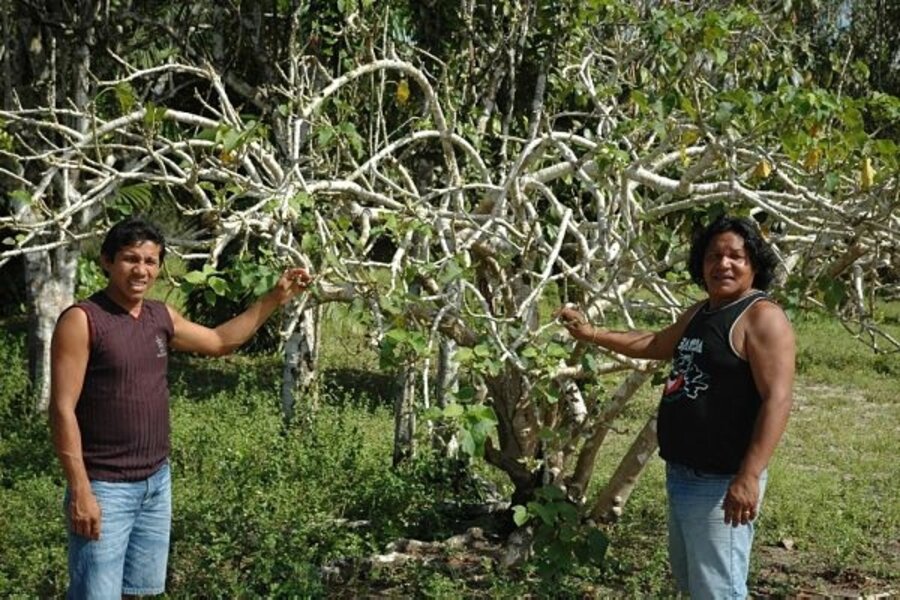Going beyond organic: analog forestry
Loading...
Even on his best days in Sri Lanka’s central highland mountains, running the family tea export business, T.P. Letchumana Raj always imagined that he would diversify into other crops. He had seen the tea trade suffer in the late 1980s, but beyond the plantation grounds he had also seen harmful modern land management lead to environmental blight and financial ruin.
So Mr. Raj turned to organic cultivation – with a twist. Instead of merely changing farm practices, he melded agriculture with the surrounding forests. Carefully selecting tree, shrub, and vine plantings, he created complex ecosystems capable of producing crops for people while providing habitat for birds, insects, and animals. By 1992 his company, Lanka Organics, had become a pioneering producer, marketer, and exporter of certified organic produce – first tea, then cashews, spices, coconuts, mangoes, papayas, pineapples, and tamarind pods cultivated through a now internationally recognized agroforestry system known as analog forestry.
“The idea was to go beyond organic,” says Raj. Lanka Organics sells certified products to Australia, Europe, and Japan, and has marketing plans drawn up for the United States.
Although the trade volumes are minuscule, just a few million dollars’ worth per year, the idea has spread to more than 20 countries, including Brazil, India, Ecuador, and Peru. Soon to appear on European store shelves: tea and chocolate marketed under analog forestry’s certification, called Forest Garden Products.
This kind of restoration ecology has gained momentum in recent years because of a glaring biodiversity problem within many organic agriculture and sustainable forestry systems. Often producers are simply replacing one monoculture – a field devoted to a single crop – with another. The result may be less pesticide and synthetic fertilizer use, but leaders in the organic movement – from developing nations to the US – are beginning to wonder how sustainable that is.
“Organic certification calls for either mixed or intercropped cultivation, but this is not strictly adhered to,” says Deva Vikrnatha, who conducted some of the first internationally recognized organic inspections in China, Indonesia, and Pakistan and is now in charge of Forest Garden Products certification. Analog forestry closes this loophole by broadening biodiversity concerns beyond vegetation to include the impact of soil, water, and tree and plant cover on the ecosystem.
The inspiration for Forest Garden Products was Sri Lanka’s long tradition of “home gardens,” where locals grew a wide variety of food on cultivated land interspersed with forest. Looking for an alternative to monocultures of pine and eucalyptus tree farms, Sri Lankan ecologist Ranil Senanayake in 1982 developed the concept of analog forestry. The big idea: By encouraging villagers to plant carefully selected trees in their farm plots, they could rejuvenate degraded ecosystems and restore biodiversity while growing crops that would feed themselves and, perhaps, command premium prices in developed nations.
One of Dr. Senanayake’s earliest successes was with 50 Maho villagers in northwest Sri Lanka. In the early 1990s, the farmers were living in mud houses on $20 a month and had very little knowledge of sustainable farming concepts, recalls Raj. Senanayake brought in Raj’s Lanka Organics to work with the villagers on developing access to higher-priced organic markets.
They thrived under the program, Raj says, more than tripling their income while restoring habitat in what was formerly an ecologically devastated area.
Another Forest Garden Products success: The Sateré-Mawé tribes in Brazil are successfully selling certified guarana fruit in Europe and Asia. The fruit is used in vitamin supplements and is found in soft drinks sold around the world.
You can raise any food with analog forestry, says Mr. Vikrnatha. What’s needed for certification is a minimum 40 percent shade cover on the property, he adds, so even with rice, which is typically cultivated in open fields, providing a stand of forest apart from the paddy enables certification.
Finding markets for these certified products remains the biggest challenge.
One solution is to persuade the organic community to adopt higher biodiversity standards. That way, crops grown in forests could achieve special recognition, not only for the organic way they’re produced but also for the habitat they preserve.
Already the influential International Federation of Organic Agriculture Movements has accepted the biodiversity science underlying analog forestry, moving recently to incorporate it into its recommended system of best practices.
Within the US organic movement a similar discussion is now taking place, but so far its import is largely confined to preventing monoculture practices.
In Montana, “We have the most acreage of organic wheat in the country,” says Barry Flam, a member of the National Organics Standards Board who has pushed the board to place greater emphasis on biodiversity. “When I talk to our state [organic] certifier, he’s rather embarrassed that a lot of that has come at the expense of grasslands.”
Transmitting this to the consumer will be hard. For one thing, consumers focused on sustainability are more concerned about fair trade and animal welfare than analog forestry, says Urvashi Rangan, a senior scientist with Consumers Union.
“It’s up to the FGPs [Forest Garden Products labels] of the world to be able to market themselves by creating an awareness of the value of their certification,” says Joel Dee of Edward & Sons, a pioneering California-based organic foods trader that buys Lanka Organics coconuts and mangos but doesn’t yet market the FGP label. “If they can do this, then it behooves guys like me to get behind them.”
One key ally of the movement is Guayapi Tropical, the French company representing the Sateré-Mawé tribes. Its president, Claudie Ravel, has long championed organic and fair-trade products and is now campaigning for analog forestry with the French government and European Commission.
Ms. Ravel sees greater understanding of biodiversity in the trade in France, Germany, and Belgium and remains optimistic that Europe is ready to embrace higher biodiversity standards.
“It’s a niche,” she adds, “but we are growing every year now because we now see consumers who understand the challenge of a future with climate change.”





